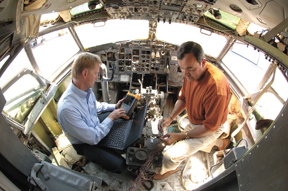
In 2007, only one research team in the nation received the Federal Laboratory Consortium’s Interagency Partnership Award for Excellence in transferring federal technology to the commercial marketplace.
Larry Schneider (1650), R. Kevin Howard, Michael Dinallo, and Steve Glover (all 1653) won for their team’s work in creating a commercially viable technique capable of spotting potential short circuits in airplanes before their misfirings cause damage, thus reducing risks of catastrophic in-flight failures.
The PASD (pulse arrested spark discharge) technique was developed largely through a partnership with the Federal Aviation Administration. The technique, proven after years of development and testing at Sandia, was transferred last year to the private sector.
Wrote DOE Secretary of Energy Samuel Bodman, “PASD is the world’s first wiring diagnostic tool that can detect and locate a broad range of aircraft defects, such as breached insulation, chafing, and small insulation cracks, and because of this detection will save lives.”
Sandia VP Rick Stulen: “This is a perfect example of innovation stemming from the intersection of world-class science and engineering capabilities at Sandia that I’m eager to stimulate further throughout our technical communities. Congratulations [Larry and your team] on an extraordinary accomplishment.”
Says Larry, “The final step was finding the right commercial partner. Astronics Advanced Electronics Systems recognized PASD’s capabilities and then brought to bear their significant expertise to field a system within months. PASD’s first use in a National Transportation Safety Board accident investigation yielded exceptional results. ArcSafe® [the commercial name for PASD and other test technology] is just now coming to market, but its future looks very bright.”
Sandia also had three winners in the more populated but still selective “Award for Excellence in Technology Transfer” category. Those selected also received a congratulatory letter from Bodman.
Craig Smith (8529) and Ernest Friedman-Hill (8964) were winners for “Jess® – the Rule Engine for the Java™ Platform.” The program is a tool for building intelligent software that can be repeatedly applied as an expert system to difficult or ill-defined systems when rote computation won’t do. It has been applied to problems in technology, insurance, and financial services, as well as in academic artificial intelligence research, and has been licensed to hundreds of academic institutions.
Nathan Golden (9104), Tom Anderson), Bill Camp (ret.), Art Hale (4600), and Mark Allen (5434) won for Novint’s 3-D haptic technology software that adds interactive, realistic virtual touch capabilities to human-computer interactions. Among the uses might be medical applications, remote vehicle or robotic control, military applications, and video games. Users are said to feel realistic weight, shape, texture, dimension, dynamics, and force effects.
An improved solar design won an award for David King, Paul Smith (9104), James Gee, Mark Allen (5434), and Jeffrey Nelson (6337). The breakthrough photovoltaic cell design and fabrication process for Advent Solar moves current-carrying electrical circuits from the front surface of the cell, where they unavoidably block sunlight, to the back surface where the backside wiring carries the current away. In addition to being more efficient, the advance — which uses a laser to drill holes through a silicon substrate and form conductive channels from front to rear surfaces — is said to lower costs by eliminating front-to-back assembly. And the design is aesthetically pleasing, a quality not often mentioned in connection with Sandia advances.
National winners were culled from a field of more than 250 federal laboratories, research centers, and facilities represented by the FLC.
In regional victories, Sandia itself won a Mid-Continent Region Award for overall achievement.
The “Athena Radar-Responsive Tag Sensor” garnered an Outstanding Technology Development Award. In Outstanding Partnerships, the University Alliance program and the Sandia Science and Technology Park were winners.
Sandia’s “Computational Analysis Tools for Goodyear Assurance Tires — Featuring Triple-Tred Technology” received an honorable mention.
Organized in 1974, the Federal Laboratory Consortium for Technology Transfer serves as a loose nationwide network of federal laboratories that provides a forum to develop strategies for linking laboratory mission technologies with the marketplace.